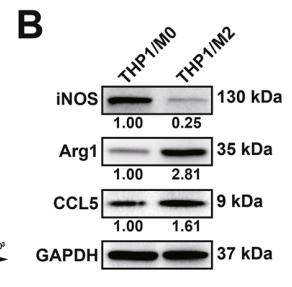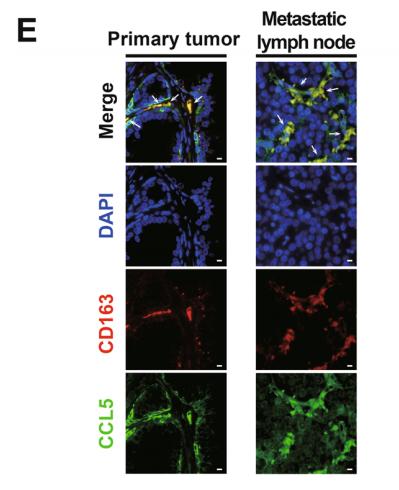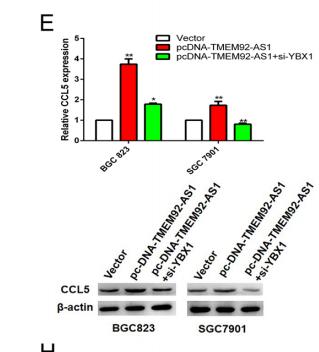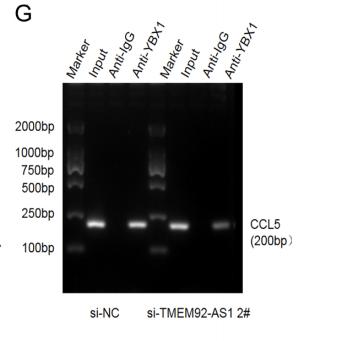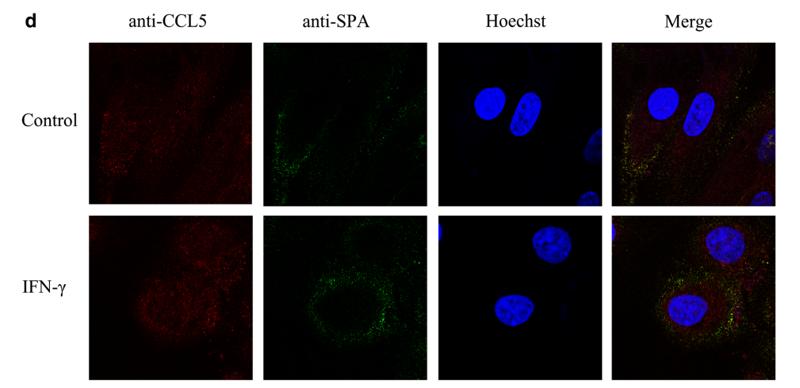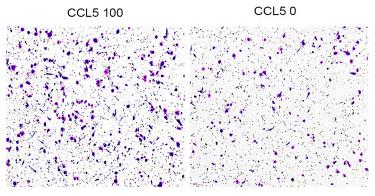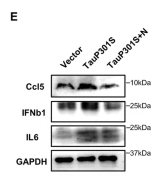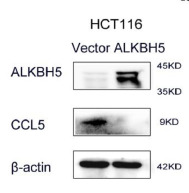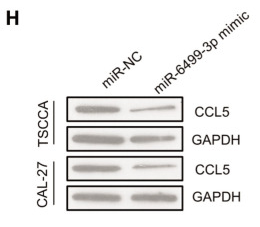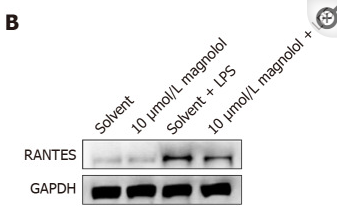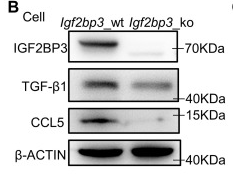RANTES Antibody - #AF5151
| Product: | RANTES Antibody |
| Catalog: | AF5151 |
| Description: | Rabbit polyclonal antibody to RANTES |
| Application: | WB IHC |
| Cited expt.: | WB, IHC |
| Reactivity: | Human, Mouse, Rat |
| Prediction: | Pig, Bovine, Horse, Sheep, Rabbit, Dog |
| Mol.Wt.: | 9 kDa; 10kD(Calculated). |
| Uniprot: | P13501 |
| RRID: | AB_2837637 |
Related Downloads
Protocols
Product Info
*The optimal dilutions should be determined by the end user. For optimal experimental results, antibody reuse is not recommended.
*Tips:
WB: For western blot detection of denatured protein samples. IHC: For immunohistochemical detection of paraffin sections (IHC-p) or frozen sections (IHC-f) of tissue samples. IF/ICC: For immunofluorescence detection of cell samples. ELISA(peptide): For ELISA detection of antigenic peptide.
Cite Format: Affinity Biosciences Cat# AF5151, RRID:AB_2837637.
Fold/Unfold
Beta chemokine RANTES; Beta chemokine RANTES precursor; C C motif chemokine 5; CCL 5; CCL5; CCL5_HUMAN; Chemokine (C C motif) ligand 5; Chemokine CC Motif Ligand 5; D17S136E; EoCP; Eosinophil chemotactic cytokine; MGC17164; RANTES(4-68); Regulated upon activation normally T expressed and presumably secreted; SCYA 5; SCYA5; SIS delta; SIS-delta; SISd; Small inducible cytokine A5 (RANTES); Small inducible cytokine A5; Small inducible cytokine subfamily A (Cys Cys) member 5; Small-inducible cytokine A5; T cell specific protein p288; T cell specific RANTES protein; T cell-specific protein P228; T-cell-specific protein RANTES; TCP 228; TCP228;
Immunogens
A synthesized peptide derived from human RANTES, corresponding to a region within the internal amino acids.
Expressed in the follicular fluid (at protein level). T-cell and macrophage specific.
- P13501 CCL5_HUMAN:
- Protein BLAST With
- NCBI/
- ExPASy/
- Uniprot
MKVSAAALAVILIATALCAPASASPYSSDTTPCCFAYIARPLPRAHIKEYFYTSGKCSNPAVVFVTRKNRQVCANPEKKWVREYINSLEMS
Predictions
Score>80(red) has high confidence and is suggested to be used for WB detection. *The prediction model is mainly based on the alignment of immunogen sequences, the results are for reference only, not as the basis of quality assurance.
High(score>80) Medium(80>score>50) Low(score<50) No confidence
Research Backgrounds
Chemoattractant for blood monocytes, memory T-helper cells and eosinophils. Causes the release of histamine from basophils and activates eosinophils. May activate several chemokine receptors including CCR1, CCR3, CCR4 and CCR5. One of the major HIV-suppressive factors produced by CD8+ T-cells. Recombinant RANTES protein induces a dose-dependent inhibition of different strains of HIV-1, HIV-2, and simian immunodeficiency virus (SIV). The processed form RANTES(3-68) acts as a natural chemotaxis inhibitor and is a more potent inhibitor of HIV-1-infection. The second processed form RANTES(4-68) exhibits reduced chemotactic and HIV-suppressive activity compared with RANTES(1-68) and RANTES(3-68) and is generated by an unidentified enzyme associated with monocytes and neutrophils. May also be an agonist of the G protein-coupled receptor GPR75, stimulating inositol trisphosphate production and calcium mobilization through its activation. Together with GPR75, may play a role in neuron survival through activation of a downstream signaling pathway involving the PI3, Akt and MAP kinases. By activating GPR75 may also play a role in insulin secretion by islet cells.
N-terminal processed form RANTES(3-68) is produced by proteolytic cleavage, probably by DPP4, after secretion from peripheral blood leukocytes and cultured sarcoma cells.
The identity of the O-linked saccharides at Ser-27 and Ser-28 are not reported in. They are assigned by similarity.
Secreted.
Expressed in the follicular fluid (at protein level). T-cell and macrophage specific.
Belongs to the intercrine beta (chemokine CC) family.
Research Fields
· Environmental Information Processing > Signaling molecules and interaction > Cytokine-cytokine receptor interaction. (View pathway)
· Environmental Information Processing > Signal transduction > TNF signaling pathway. (View pathway)
· Human Diseases > Neurodegenerative diseases > Prion diseases.
· Human Diseases > Infectious diseases: Bacterial > Epithelial cell signaling in Helicobacter pylori infection.
· Human Diseases > Infectious diseases: Parasitic > Chagas disease (American trypanosomiasis).
· Human Diseases > Infectious diseases: Viral > Influenza A.
· Human Diseases > Infectious diseases: Viral > Herpes simplex infection.
· Human Diseases > Immune diseases > Rheumatoid arthritis.
· Organismal Systems > Immune system > Chemokine signaling pathway. (View pathway)
· Organismal Systems > Immune system > Toll-like receptor signaling pathway. (View pathway)
· Organismal Systems > Immune system > NOD-like receptor signaling pathway. (View pathway)
· Organismal Systems > Immune system > Cytosolic DNA-sensing pathway. (View pathway)
References
Application: WB Species: Mouse Sample: HT22 cells
Application: WB Species: human Sample: prostate cancer cells
Application: IF/ICC Species: human Sample: prostate cancer cells
Application: WB Species: human Sample: BGC823 and SGC7901 cells
Application: WB Species: human Sample: BGC823 cells
Application: WB Species: human Sample: BGC823 cells
Application: WB Species: human Sample: BGC823 cells
Application: WB Species: Cows Sample: bovine mammary epithelial cells (BMECs)
Application: IHC Species: Cows Sample: bovine mammary epithelial cells (BMECs)
Application: WB Species: Human Sample: HCT116 and SW620 cells
Application: IHC Species: Human Sample: HCT116 and SW620 cells
Restrictive clause
Affinity Biosciences tests all products strictly. Citations are provided as a resource for additional applications that have not been validated by Affinity Biosciences. Please choose the appropriate format for each application and consult Materials and Methods sections for additional details about the use of any product in these publications.
For Research Use Only.
Not for use in diagnostic or therapeutic procedures. Not for resale. Not for distribution without written consent. Affinity Biosciences will not be held responsible for patent infringement or other violations that may occur with the use of our products. Affinity Biosciences, Affinity Biosciences Logo and all other trademarks are the property of Affinity Biosciences LTD.

